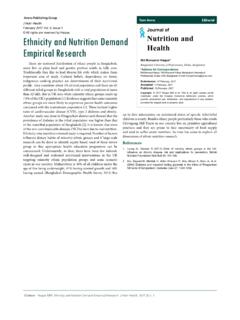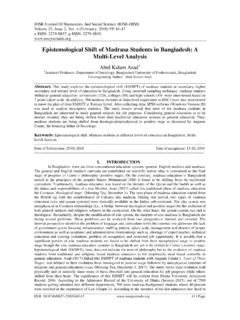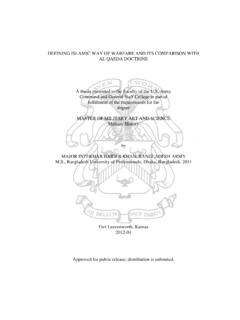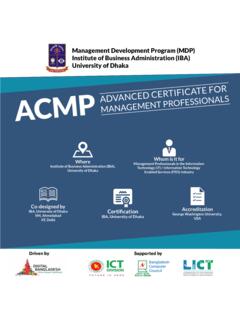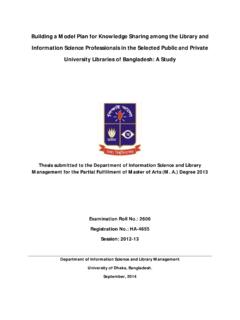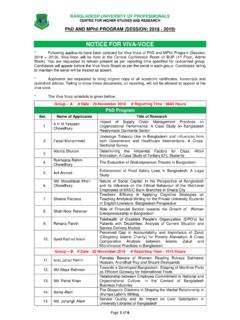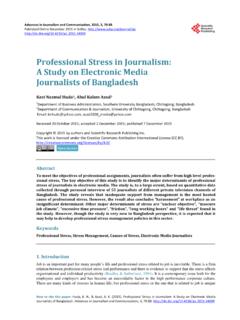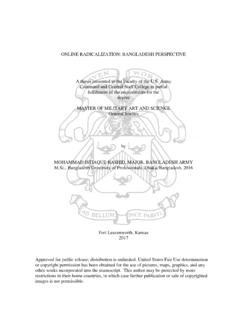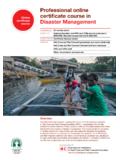Transcription of COUNTRY SUMMARY BANGLADESH - World Bank
1 Conference on Governance and Financing of Higher Education South and East Asia COUNTRY SUMMARY BANGLADESH . Context, size and shape The demand for higher education opportunities in BANGLADESH has increased dramatically over the past two decades which resulted in a significant expansion of the tertiary education system in the COUNTRY since 1990s. At present, there are 82 universities in BANGLADESH of which 51 are private and 31. are public universities. The expansion appears to be spectacular when compared to only seven in mid 1980s and four universities at the time of independence in 1971 all of which were publicly financed autonomous entities. While the number of students has gone up both in public and private universities, the rise in the enrollment in the private universities in the recent years deserves considerable attention.
2 Private universities are a relatively new phenomenon in this COUNTRY . In early 1990s, private sector came forward to establish universities. Since then, the COUNTRY experienced a spectacular growth in private universities mostly in and around Dhaka and couple of other large cities. In 2009, private universities had a combined enrolment of more than 200,000, more than 40 per cent of the total enrollment in all universities. Enrollment in the public universities has also been growing and so is the case with the colleges awarding bachelors and master degrees under the National university . At present more than million students are receiving higher education in BANGLADESH . SUMMARY Data Table on Higher Education (Data from 2009). Enrollment Total 1,583,155.
3 % of Female 38%. % of Private Student/Teacher Ratio Public 18:1. Private 22:1. National 14:1. Total Public Expenditure on % of GDP Education Total Public Expenditure on % of total education budget Higher Education Number of HE Institutions Total 82. Public 31 (including Open university and National university ). Private 51 ( except for 3 under dispute National 1 (catering 1778 tertiary colleges). Source: Quality Issues of Higher Education in BANGLADESH ; Professor Dr. Salahuddin, Dept. of Public Administration, university of Dhaka; 2007. Tertiary education in BANGLADESH comprises two categories of institutions: degree awarding universities and colleges affiliated to the National university (NU). Number of colleges providing tertiary level education is 1778.)
4 Most of them offer BA (pass) education of three years' duration and only one-third of them offer (Honors) and even fewer, Masters level courses. All of these colleges are affiliated with the NU, meaning, NU awards the degrees. Nevertheless, access to tertiary level education in BANGLADESH is still very limited. Only about 12% of the year twelve graduates can enter into HE. Some 75 per cent of these students are in the NU affiliated colleges. Public versus Private Universities: Public universities that maintain the low tuition fees attract the best students, partially because of their better reputation than that of the emerging private universities. Also, public universities offer certain courses that are not offered by the private universities, for example: civil engineering, physics, chemistry etc.
5 Except for courses on BBA, MBA, 1. Conference on Governance and Financing of Higher Education South and East Asia computer science and medical science, public and private universities do not compete much for potential students. Issues in BANGLADESH 's Higher Education System Access Access is very limited with a little more than 4% of the 17-23 age cohort receiving higher education The absence of a national strategy for research Relevance Linkages between university and industry are weak. Lack of Information on graduate employment No accreditation body exists for quality assurance and to determine the strengths and deficiencies of programs. Low quality, particularly in some of the newer private universities and in the Quality affiliated colleges The difficulties in recruiting, retaining and offering adequate professional development opportunities to academic staff Lack of internal and external quality assurance measures Low levels of government funding and a very high percentage of that funding Financing allocated to salaries, leading to inadequate funding for research, equipment, computers, books and journals and building maintenance.
6 Governance/ The governance arrangements in the public universities and many HE colleges Management are influenced by the political environment of the COUNTRY . It is generally agreed by academics, education researchers and other stakeholders that the quality of HE in BANGLADESH has declined steadily over the last two decades ; The fall in quality has become a core concern of the government1. Furthermore, BANGLADESH being a human resource export COUNTRY would miss the opportunity to get an access to the competitive regional and global employment market if quality does not match quantity. Specific governance arrangements university Grants Commission (UGC) as the apex body of the government for HE is responsible for funding of public universities. Though Private universities do not get any government assistance in terms of funding, they need to receive approval from the UGC to operate and award degrees.
7 Tertiary colleges are under the NU. However, the NU's responsibility is limited to setting up curriculum and organizing and administering exams. The teachers for the colleges are recruited through the nation wide competitive Public Service examination, administered by the Public Service Commission. Ministry of Education (MoE) is responsible for posting, transfer and promotion of teachers in the colleges. Quality Assurance: Absence of quality assurance mechanism is a critical issue in BANGLADESH . Each public university relies on its own mechanism to ensure quality. This mechanism includes curriculum reviews by the Curriculum committee, assessment of achievement and designing future action plans by the Academic Council etc. There is no provision for external review of quality for the universities.
8 The NU is responsible for maintaining the quality at the tertiary level colleges. Nevertheless, the NU. 1. Quality Issues of Higher Education in BANGLADESH ; Professor Dr. Salahuddin, Dept. of Public Administration, university of Dhaka; 2007. 2. Conference on Governance and Financing of Higher Education South and East Asia is busy mostly with arranging exams and publishing results and there is no activity to ensure quality of the affiliated colleges. The UGC carries out monitoring of private universities to a limited extent. The private universities need UGC's permission to open and operate departments. However, most of the private universities have failed to meet the minimum requirements of physical infrastructures, fulltime qualified faculty, libraries, teaching aids and other facilities to provide proper education.
9 Recent reforms in governance In 2003, realizing the urgent need for reforms and overall strategy for HE, the Ministry of Education decided to develop a 20-Year Strategic Plan for the higher education sector. Under the guidance of the university Grants Commission (UGC), six expert groups comprising of scholars and professionals of the COUNTRY prepared the strategic plan. After a series of regional and national level consultative meetings, the UGC finalized the Strategic Plan in May, 2006 which was then accepted by the Government as the National Strategic Plan for Higher Education for the next 20 years. The strategic plan highlights major challenges facing the sector in BANGLADESH and recommends strategies to address the issues. The strategic plan recognizes, among others, limited access, weak governance and management of institutions, and low quality of higher education are the major issues which need to be addressed.
10 The Plan proposes a number of policy reforms and interventions to be implemented in three consecutive phases. Some of the key recommendations made by the Plan are: (i). de-politicization of public universities; (ii) setting up a national search committee for selecting Vice- chancellors and other senior officials; (iii) strengthening of UGC; (iv) establishment of accreditation council; (v) enhanced support for research; and (vi) development of strategies for retaining and developing quality teaching staff. Specific financing arrangements The Government of BANGLADESH funds public universities through the university Grants Commission (UGC). So far little policy has been prescribed for addressing financing higher education2. Passing the Higher Secondary Certificate (HSC) examinations is a prerequisite for entering HE in BANGLADESH .










